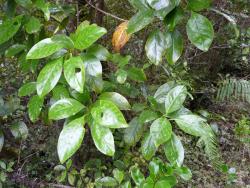- Taxon
- Gallery
- = Coprosma autumnalis Colenso, Trans. & Proc. New Zealand Inst. 19: 263 (1887)
Shrub or tree up to c. 6 m. tall; trunk slender (not always developed); branches and branchlets rather stout, glab. Lvs on petioles ± 2–5 cm. long. Stipules tapering from rather broad base to 2 conspicuous denticles, glab. Lamina membr. to subcoriac., subglossy green above, paler below, broadly elliptic to obovate; apex subacute, sts apiculate; rather gradually narrowed to petiole; (10)–15–20 × (5)–7–10 cm.; margins sts waved, sts ± crenulate. Reticulations close, conspicuous or evident on both surfaces. Fls in clusters on trichotomously branched peduncles up to c. 6 cm. long. ♂ with 4–5-toothed cupular calyx; corolla narrow-funnelform, lobes us. 5, acute, < tube; stamens us. 5. ♀ us. with small stipulate bracts at axils of branches; calyx-teeth us. 5, small, acute; corolla tubular, lobes 5, narrow-triangular, acute, ± = tube. Drupe reddish orange, oblong, 7–9 mm. long.
[From: Allan (1961) Flora of New Zealand. Volume 1 as Coprosma australis (A.Rich.) Robinson]




